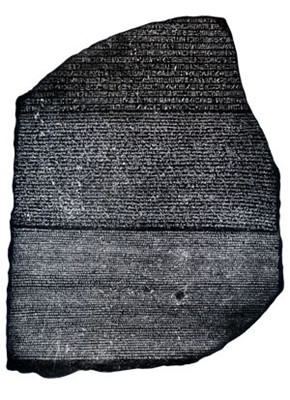Every day I walk through the Egyptian sculpture gallery at the British Museum, and every day there are tour guides, speaking every imaginable language, addressing groups of visitors who are craning to see the object that I will be talking about in this programme.
每天,我走過大英博物館的埃及雕像廳時,總有操著各國語言的導游帶領著一團團游客在那里參觀。游客們都伸長了脖子觀看這件展品。
It is on every visitor's itinerary and, with the mummies, it is the most popular object in the British Museum.
每一位游客的游覽計劃里都有它。它和木乃伊是大英博物館內最受歡迎的藏品。
Why? To look at, it is decidedly dull - it is a grey stone, about the size of one of those large suitcases you see people trundling around on wheels at airports, and the rough edges show that it's been broken from a larger stone, with the fractures cutting across the text that covers one side.
為什么?它的外表毫無特色,只是一塊灰色的石頭,大小如同機場常見的人們拖在手里的帶輪大行李箱。粗糙的邊緣表明,它只是一塊更大的石頭的碎片。石片的一面布滿文字,
And when you read that text, it's pretty dull too-it's mostly bureaucratic jargon about tax concessions.
但如果你駐足閱讀,便會發現那文字的內容也很乏味:
But, as so often in the British Museum, appearances are deceiving, because this dreary bit of broken granite has played a starring role in three fascinating and different stories:
是一份關于稅收優惠的官方文件。但光看外表是不行的,博物館中的很多物品都是如此。這塊外表沉悶的花崗巖碎片在三個精彩的故事中都扮演了重要角色:
the story of the Greek kings who ruled in Alexandria after Alexander the Great conquered Egypt;
亞歷山大大征服埃及后,統治亞歷山大港的歷任希臘國王的故事;
the story of the French and British imperial competition across the Middle East after Napoleon invaded Egypt;
拿破侖入侵埃及后,英法爭奪中東的故事;
and the extraordinary but peaceful scholarly contest that led to the most famous decipherment in history-the cracking of hieroglyphics.
以及學者們和平競爭、破解埃及象形文字的故事。












